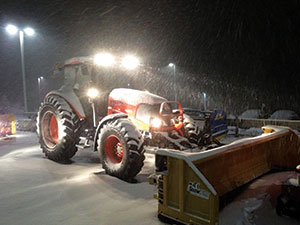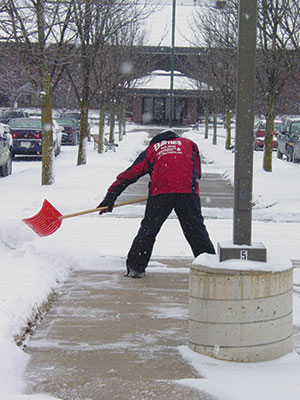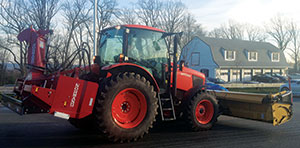Three snow contractors put a new twist on winter’s residential market.
When winter’s icy tendrils snake their way through the northern part of the country, many contractors put the mowers away and attach plows to the fronts of their trucks. But today they’re doing so on the heels of a couple seasons where snowfall was erratic and unpredictable.

Photo: Xtreme Snow Pros
In the face of such uncertainty, contractors can’t confidently rely on the residential market to earn their winter keep, and many of them have come to prefer the steadier, long-term income generated by commercial accounts.
Nonetheless, snow contractors have found several ways to differentiate themselves and make money from their residential services. Here’s a look at how three contractors are doing just that.
Short-term accounts
Madison, Wis.-based Barnes Inc. provides both commercial and residential service during the long Wisconsin winters. And while the bulk of the winter income is derived from the commercial accounts, Barnes is growing its residential base, often with the clients dropped by competitors leaving this part of the market.
“It’s a balancing game,” says Chris Schultz, quality control coordinator and sidewalk snow removal division manager for Barnes.
“When you transition to residential, you have to do that in a timely fashion,” he says. “Getting to your residential accounts as soon as you can after your commercial accounts is the challenge.”
Barnes is large enough and flexible enough to offer traditional snow services along with vacation and emergency services. Many customers are content to take care of their own driveways—until a big snow comes along. Nobody wants to shovel a 15-in. snowfall, Schultz says.
“Because we are so big, we’re able to take on customers for a short period of time,” he says.

Even when the snows don’t pile up quite that high, many customers call on Barnes to provide services while they’re away for the holidays or on a business trip. They hire Barnes to take care of their properties during those times.
“We’re very flexible like that,” Schultz says. “Whenever our customers are gone and need snow removal services, we’re there for them. It’s a nice service to be able to offer for people because it’s one less thing they have to worry about. One less thing customers want to do is come home to three fines because their snow removal wasn’t done. It’s one phone call. It’s peace of mind for them.”
It’s all about delivering on a need. “We’ve been doing that forever,” Schultz says. “It’s one of our selling points. We’ll pick up full-time customers from that because they’re so happy with our service that we’re able to fit them in for a week or two. They don’t want to continue to do their own snow removal, so they’ll hire us out for the rest of the season. It’s a nice service for our customers because we’re able to take the work on and not lack any quality or service.”
Concierge service
The unpredictable nature of winter weather often brings late night and sometimes very long hours.

When he first entered the Green Industry, Aaron Smith worked in snow removal for a large landscaping company in Minnesota.
“I could be gone for 80 hours straight and not see anybody, not sleep and barely eat,” says Smith, general manager/sales manager for Essex, Vt.-based S&D Landscapes. “It was fun for the first two events. After that it got kind of old.”
It was old for his new bride, too, and Smith promised when he started working in the family business he wouldn’t work those hours again. Yet the allure of winter income proved too strong.
Not wanting to break his promise to his wife, Smith had to find a way to bring in the income without working those long hours. Smith’s solution was to offer a highly personal, higher-margin concierge snow removal service.
“We use walk-behind snow blowers,” Smith says. “We service some of our summer clients and a few who are not. The minimum charge is $45 for a single width or a very short double-width driveway from 3 in. to 6 in. of snow. More than 6 in. is $65. In the case of continuous snow, we’re trying to be there every 4 in.”
The route is small and Smith uses only two workers. And the service includes more than just clearing snow from a driveway.
“If your car is in the driveway, the car will get brushed off,” Smith says. “It does not get scraped for ice for liability reasons. We hand shovel around all the cars so there is no snow underneath the car. We snow blow the front walks and city walks.”
Because S&D only provides the concierge snow removal to a few customers, the service can be customized, such as clearing a client’s back deck by request.
“The beauty of it is, it was an afterthought,” Smith says. “Because our budget is set up to recover in the summer, this boils down to extra operating capital and keeping guys busy.”
Smith acknowledges it’s been difficult to manage expectations. Two years ago there wasn’t that much snow, and customers were thrilled with the service. Last year, when the snow was much heavier, some customers found themselves with a $500 monthly bill.
That said, Smith has some very devoted followers.
“We looked at doing something else, expanding in a different direction, and we got some push back when we suggested we would drop the service,” Smith says.
Tractor-based approach
Chris Marino, owner of Xtreme Snow Pros of Mahwah, N.J., visited a Montreal, Canada-based colleague to learn about the approach contractors there take to snow management.

“They do residential snow a whole different way than we do in the U.S.,” Marino says. “By studying their business model I realized how efficiently they were doing things.”
That method involves putting a 92-in. inverse snow blower on the back of an agricultural tractor. Instead of taking 15 minutes or more to plow a driveway, the new setup can clear a driveway in just a couple minutes. The method is so efficient, Canadian contractors can charge less than Americans and still make more money.
In addition to the ability to clear a driveway quickly, the snow blower offers another advantage over plowing. State law forbids leaving any snow in the street. The snow blower allows Xtreme’s employees to direct where the snow goes.
There are some challenges to the business model. In Canada, customers are more willing to sign season-long contracts.
“The U.S. market doesn’t think about snow the way Canadian market does,” Marino says. “In the Canadian market, snow is a part of their life. Where I’m stumbling is with the idea of getting people to think about snow in September. I don’t want them signing up in December, I want them signing up earlier on so it’s all routed correctly.”
Marino is still tweaking the model to make it work for his company. He plans to add another tractor next season to expand the service. When it comes to making money in winter, it’s simply a matter of considering all the options.

“Open your eyes to new ideas,” Marino says. “There are other ways of doing things out there that break the mold of the traditional way. In today’s market, which is so competitive, you have to invest in efficiency in order to remain competitive.”

